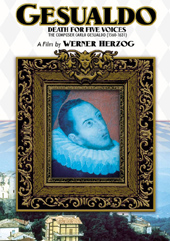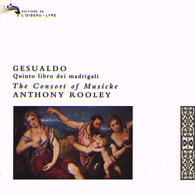| Release List | Reviews | Price Search | Shop | Newsletter | Forum | DVD Giveaways | Blu-Ray/ HD DVD | Advertise |
| Reviews & Columns |
|
Reviews DVD TV on DVD Blu-ray International DVDs Theatrical Reviews by Studio Video Games Features Collector Series DVDs Easter Egg Database Interviews DVD Talk TV DVD Talk Radio Feature Articles Columns Anime Talk DVD Savant HD Talk Horror DVDs Silent DVD
|
DVD Talk Forum |
|
|
| Resources |
|
DVD Price Search Customer Service #'s RCE Info Links |
|
Columns
|
 |
Savant Review:Gesualdo: |

|
Gesualdo: Death for Five Voices Image Entertainment 1995 / Color / 1:78 Anamorphic 16:9 / 60m. / Starring Il Complesso Barocco, Director Alan Curtis; Gesualdo Consort of London, Director Gerald Place. Cinematography Peter Zeitlinger Film Editor Rainer Standke Writing credits and Produced by Lucki Stepetic Directed by Werner Herzog |
Produced for German television, and apparently shot on digital video, Gesualdo: Death for Five Voices is a quirky and uneven documentary about a very obscure composer, who led a horrid life worthy of Vincent Price and Edgar Allan Poe.
This is apparently an English re-edit of a German original, for the titles all come up in English, with a few misspelled. Werner Herzog, a great raconteur on his Anchor Bay DVDs, revoices the many Italians on screen. This is hard to follow sometimes, prompting the wish that the picture had simply been subtitled.
The madrigal performances are outstanding. Steven Nielson turned Savant on to Gesualdo through a CD 1 in about 1996; the opening track on the disc blew me away.

Say 'madrigal', and my previous response would have been 'boredom'; but these songs are entirely different. Forgive Savant's ignorance of the correct musical terms. The 5 voices that interweave the morbid Italian lyrics of these songs, create some weird harmonies, or anti-harmonies ... they're rather indescribable. Sometimes the strange phrasing causes the voices to momentarily sound as if they'd been recorded backwards. I'm tempted to use words like dissonant, which I don't really know how to properly apply. I strongly recommend that the adventurous try this CD out.
Even more illuminating were the liner notes on the CD, that made Don Gesualdo, Prince of Venosa, seem like the inspiration for Prince Prospero in Masque of the Red Death. His story would be the perfect springboard for the Barbara Steele movie never made, and his creepy choral compositions would sound terrific echoing through the eerie halls of the ultimate Euro-horror film.
Herzog was clearly inspired by all this, but instead of making a feature, opted for this intriguing but ultimately frustrating documentary. The musical performances are good, and the input from the experts on Gesualdo's violent and cruel life is well-presented, if a bit dry. One excellent passage has all five singers sing their parts separately, and then together. When the harmony (is that weird sound a harmony?) combines, the sum of the voices is far, far more than its parts.
But when dealing with Gesualdo's life, there's a problem navigating through some of Herzog's embellishments. Various guides in Venosa and Naples show us the actual locations of Gesualdo's crimes, as with the arch from which he suspended his little boy by a rope, swinging back and forth until he died - a process that took days, with choirs singing, no less. But Herzog throws in a busty woman who the camera pursues through the ruined castle, until she claims to be the reincarnation of Gesualdo's lost wife. Okay. Unfortunately, Herzog never explains whether she's a real kook or (we suspect) an actress helping in a restaging. This unfortunately tilts the show in the direction of the unreliable 'reality' programming that's currently the scourge of American broadcast television.
On the plus side, Herzog very creatively covers a chef in a kitchen marvelling over the recipes for one of the Prince's fantastic feasts. From the background, the chef's wife keeps interrupting, calling Gesualdo a devil (..é un diavolo!), and it's the kind of great moment that lucky Herzog always seems to get. The various uncredentialed guides, however, relate their 'facts' about Gesualdo without much evidence to back them up. A descendant of the Prince shows us a family tree that he hardly seems to take seriously, and then guides us through halls to what he claims is the very bed in which Maria Davalos was murdered - an ornate four-poster which has survived 400 years in perfect condition.
The show ends with a fascinating street performance that is also insufficiently explained. A devil character claims to be Gesualdo, while an angel character (a small boy suspended on a scary-looking cable) opposes him with his sword of truth. Flag dancers and jousting knights surround the exhibition, which provides some color for the docu but doesn't blend too well with the topic at hand.
Gesualdo is probably so obscure that Herzog had trouble finding the few facts we're given here. The musicologists have a good time discussing the melancholy Prince's wavering reputation through the centuries. Gesualdo ending up being labeled a genuius, the innovator of an expressionistic style 200 years before anything similar was heard. But there's still something missing: when the movie shows us a display of what are said to be the skeletons of Maria Davalos and her unlucky lover, we look at the macabre sight and wonder who the heck would mount such a morbid display, and where? The docu makes us want to know more. At the very least, it makes us wish Barbara Steele and Vincent Price were around to play in a gruesome horror movie about this subject.
Image's DVD of Gesualdo: Death for Five Voices is a featureless but good-looking show with a 16:9 image. I'm guessing that it was shot in Pal digital video, perhaps with some sort of added film-look that coarsens the image. Some scenes look much more like video than others. There's nothing extra at all with the disc, nothing from Herzog or about the shooting that might neutralize concerns about the show. This makes the disc desirable for enthusiasts of of either classical chamber music, or morbid history, but be careful ... one of the historians talks about a musicologist who popularized Gesualdo in the latter part of the 19th century, and so identified with him that he came to believe he was Gesualdo, and killed himself!
On a scale of Excellent, Good, Fair, and Poor,
Gesualdo: Death for Five Voices rates:
Movie: Good
Video: Good
Sound: Excellent
Supplements: None
Packaging: Keep case
Reviewed: February 7, 2002
Footnote:
1. Gesualdo, Quinto libro dei madrigali The Consort of Musicke, Anthony Rooley; Editions de L'oiseau-lyre 410 128-2
Return
|
|
| Coming Soon |
|
|
| Special Offers |
|
|
| Columns |
| Home | Release List | Coupons | Shop | Reviews | Forum | Video Games | Price Search | Advertise |








